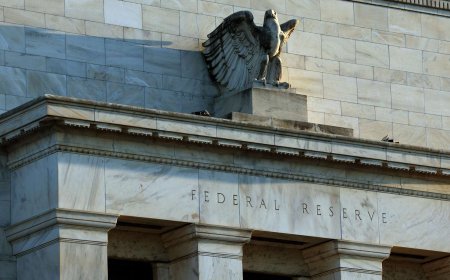Circle's IPO Filing Challenges Crypto Market Confidence After Trump's Tariff Shock
Circle’s Anticipated IPO Filing Revives Hopes for Crypto Listings, But Market Instability and Weak Financials Raise Concerns

Points to Know:
-
Circle has filed for an IPO with the SEC, becoming the first major stablecoin issuer to take this step amid a volatile market and uncertain U.S. crypto regulations.
-
Analysts highlight Circle’s declining margins and high operational costs as risks, despite the company’s bet on the long-term demand for tokenized dollars and payments infrastructure.
-
If successful, Circle’s IPO could spark renewed optimism for other crypto firms, like Kraken and Gemini, to pursue public listings, though many are expected to wait for clearer regulatory guidance in 2025.
Following President Donald Trump’s reelection in November, there was a surge of optimism among crypto companies looking to go public. Trump made significant promises, such as providing clearer regulations for the industry and working to position the U.S. as the world’s leading hub for crypto.
For a short time, it seemed like a wave of IPOs was on the horizon, with pipelines buzzing and founders imagining themselves ringing the opening bell. But underlying challenges were starting to form. A thriving market is crucial for successful public offerings, and few expected the road ahead to be as rough as it turned out to be.
Circle didn’t wait for perfect circumstances. After years of setbacks and regulatory delays, the stablecoin issuer moved forward by filing its S-1 with the U.S. Securities and Exchange Commission (SEC) on Tuesday, taking a long-awaited step toward becoming a publicly listed company.
The filing was met with a mix of excitement and skepticism. Some in the crypto industry viewed it as a positive sign—another major player moving closer to the public markets. Others questioned the timing, given the shaky market conditions. Circle's path to a successful IPO is far from assured.
"I believe Circle will be able to price their IPO and raise capital, but it won’t be easy,” said David Pakman, managing partner and head of venture investments at CoinFund. “Typically, companies going public prefer to debut during strong market conditions."
Equities have been in freefall since President Trump announced reciprocal tariffs on around 90 U.S. trade partners, including China and the European Union, heightening fears of a global recession. The S&P 500 and Nasdaq are down 11% and 17%, respectively, marking one of the worst quarters in recent years.
As a result, CloudWeave, which went public last month, had a lackluster debut, though its stock rebounded on the second day of trading, likely due to stronger investor interest in AI companies amid broader market concerns. Payments app Klarna also announced it was halting its IPO plans earlier today.
However, Circle faces more than just general market uncertainty—it also has to contend with concerns over its financials, which could make it harder to attract investors.
“While I have great respect for Circle and its leadership, their financials reveal the challenges they’ve faced with growth and the high costs of their distribution partnerships,” Pakman noted, adding that he still believes in the company's long-term potential.
Circle's IPO filing revealed declining gross margins and high spending, which come at a time when clearer stablecoin regulations could intensify competition in the market.
“Circle is being valued like a traditional crypto business — cyclical, interest rate-sensitive, and not diversified enough. If Circle can evolve into more of a payments network with high margins and strong barriers to entry, its valuation could reflect that,” wrote Lorenzo Valente, a crypto analyst at ARK Invest, on X.
Questions remain about the company’s structure, including how its revenue-sharing agreements will evolve and the growth of Base, a blockchain developed by Coinbase that uses Circle’s USDC, according to Valente.
“Circle has mitigated some risks by setting a lower valuation, but challenges remain as the implementation of digital infrastructure in the banking system will take time,” said Mark Connors, chief investment strategist at Risk Dimensions, a Bitcoin investment advisory in New York.
Circle’s rumored valuation of $4 billion to $6 billion, roughly 13 to 20 times its adjusted EBITDA, is in line with companies like Coinbase and Block, but “not necessarily cheap, especially considering its recent decline in profitability,” Valente noted.
“Despite this, we see potential growth for U.S.-backed stablecoins driven by increasing commercial use, shifting U.S. regulatory and legislative dynamics (such as the GENIUS Act), and the U.S. Treasury’s interest in finding new buyers for its expanding stockpile of U.S. T-Bills,” Connors added.
More than $6 trillion in Treasury bills will be rolled over this year, with additional issuance expected to help cover the expanding U.S. deficit.
Despite ongoing market volatility, several crypto companies remain focused on their IPO goals, including Kraken, Gemini, Blockchain.com, Bullish, and BitGo. There are also reports that other crypto firms are in discussions about going public.
However, many companies are likely to postpone their IPO plans, waiting for clearer regulatory guidelines and better market conditions. Analysts from crypto M&A advisory firm Architect Partners anticipate that the majority of IPOs will be filed in the second half of 2025, once regulations and policies are finalized.
What's Your Reaction?
 Like
0
Like
0
 Dislike
0
Dislike
0
 Love
0
Love
0
 Funny
0
Funny
0
 Angry
0
Angry
0
 Sad
0
Sad
0
 Wow
0
Wow
0




































































